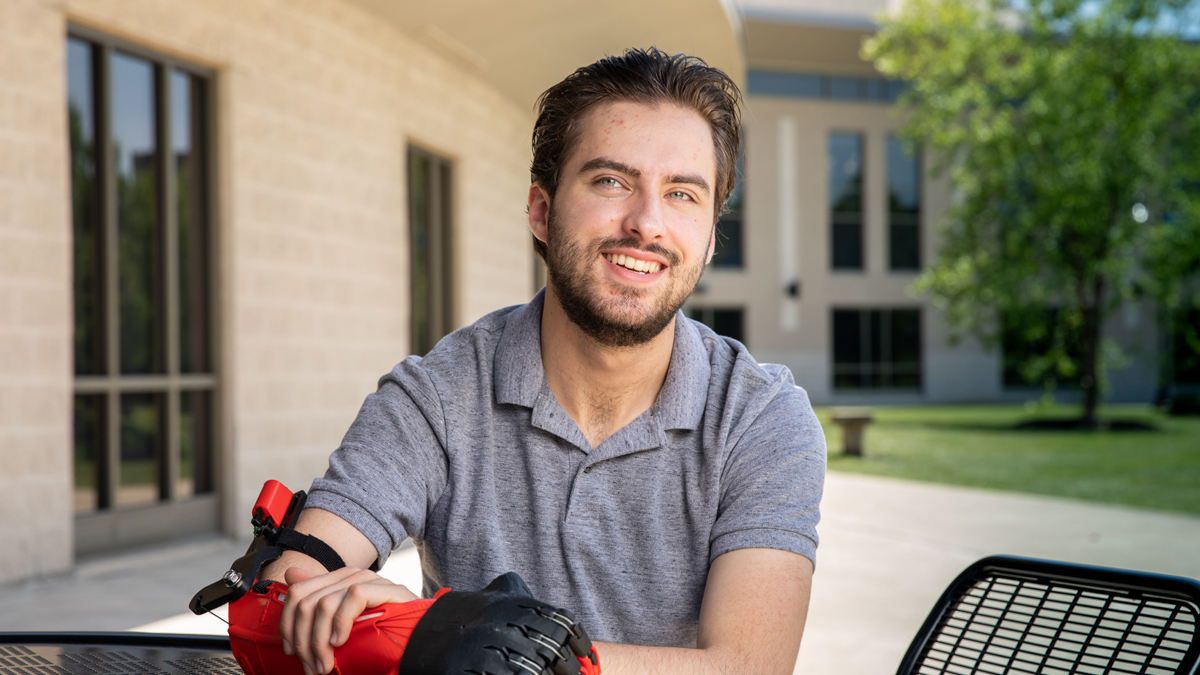Finding the resources to effect change
Aaron's innovative work with prosthetics gets boosted by Ohio State

Where we are is the 2019 version of MakerX, the Columbus Maker Expo that highlights innovative technology.
And among the 90 exhibitors and 1,300 attendees is Aaron Westbrook, founder and CEO of Form5 Prosthetics and a full-time Ohio State student.
On his exhibit table, surrounded by mechanical hands lighter than a cell phone, is the item that started it all for Westbrook.
He picks it up and passes it over. It’s a prosthetic arm from elbow to fingers. It’s heavy, maybe a pound or so, and strictly cosmetic with no functionality. Westbrook received it six years ago as a high school freshman to replace the lower right arm he was born without. Though he isn’t exactly sure how much his own cost, upper limb prosthetics generally cost $5,000 up to tens of thousands of dollars.
“By the middle of the day, I’d throw it in my locker because my shoulder ached,” says Westbrook, a sophomore business administration major at Fisher College of Business.
Unhappy with the prosthesis, and the lack of input he was given in its creation, Westbrook created his own. All he needed was a 3D printer, instructions he found online and plastic waste from his school’s cafeteria.
The prosthesis he created was light. The fingers moved. It cost [roughly] $40.
By the end of high school, Westbrook owned a 3D printer he used to customize an arm for a 7-year-old girl as part of a school project. It was the first prosthetic for his nonprofit company Form5 Prosthetics, which recycles plastic into 3D-printed prosthetics for those missing limbs.
In the three-plus years of its existence, Form5 has worked with seven people to make eight devices —helping recipients go bowling or play an instrument, for a couple examples.
“I get to be the person I needed when I was growing up,” Westbrook says. “We know better than anybody what we need. If we’re given the resources and technology to do that, we can facilitate our ideas into the prosthetics we need [to pursue a certain profession, passion, or activity].”
The spotlight shines
Westbrook has been featured in media throughout central Ohio, been invited to give a TedX talk and even set up booths at Columbus’ Arnold Sports Festival, the nation’s largest health expo that also showcases the latest trends in a variety of business communities, and MakerX.
His story has garnered a lot of attention. It even caught the eye of Lt. Gov. Jon Husted, who was alerted to complaints from Ohio’s Occupational Therapy, Physical Therapy and Athletic Trainers Board about the work Form5 was doing. Under a 2001 state law written before 3D printing, a prosthetics manufacturer is required to have a state license. That license includes bachelor’ and master’s degrees and eight months of supervised work. It can take six years to acquire.
Husted, who oversees a state agency aimed at innovating, began working with Westbrook during the summer of 2019 on an initiative to change the law. An amendment was signed into the state budget allowing unlicensed people to use 3D printing of open-source prosthetics kits.
Westbrook is worked with the board to create language for a future law that would be inclusive of work like his.
“That was a big victory,” Westbrook says. “We’re not just giving someone a device, we’re opening the door for people to get better prosthetics. The fact I was able to be that voice and represent those people was really a defining moment for me.”
A summer of transitions
Westbrook’s summer included another challenge: passing his math class to complete his freshman year at Ohio State’s Newark campus.
It was the final piece Westbrook needed before making the transition to the Columbus campus.
Westbrook started at the Newark campus a year ago after taking a gap year to concentrate on building Form5. He saw Fisher College of Business and the opportunities in central Ohio as the perfect destination to take his innovative business spirit to the next level.
“There was no doubt in my mind the best college in the state is Ohio State, and that’s really what led me here,” he says. “But I did have a lot of anxiety going back to school.”
Those worries were why he chose to start at the Newark campus, which offered a smaller setting and a closer relationship to faculty. Westbrook was also surprised by how many connections he made in the central Ohio business community and in organizations at Fisher.
“I’m incredibly grateful for the time I spent at the Newark campus,” he says. “It really prepared me well to make the transition to the Columbus campus.”